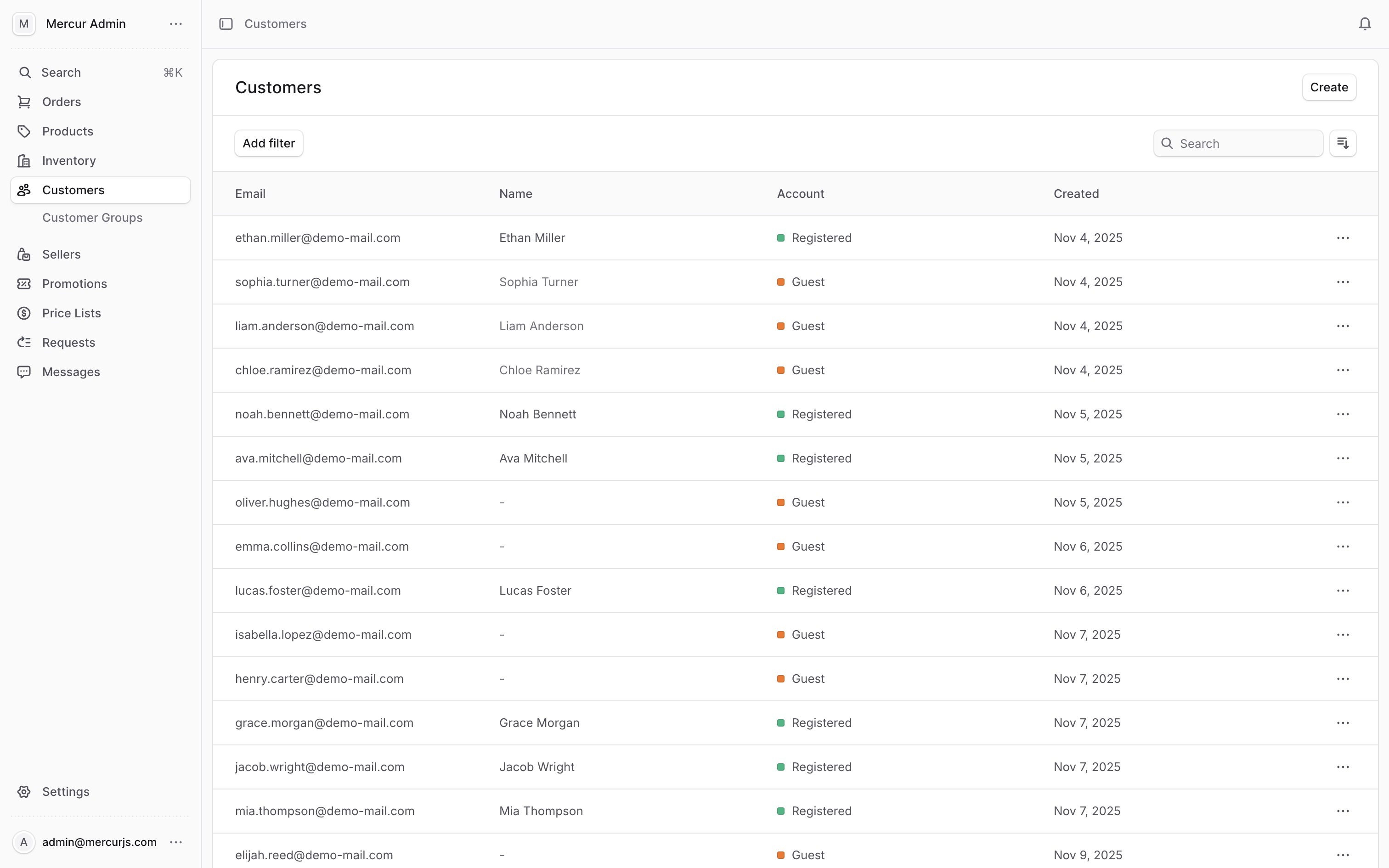Customer & Account Management
Centralize customer profiles, accounts, and groups across all channels and marketplaces with a headless customer domain built on Medusa and extended in Mercur. Mercur’s Customer module is where you keep everything you know about your buyers and accounts: who they are, how they log in, which groups they belong to, and what they’ve ordered. It gives you a single, API-first customer layer that works across DTC, B2B and marketplace scenarios - without locking you into a specific storefront or CRM.
How you manage customers in Mercur
Give your support, sales, and marketing teams one consistent view of customers, instead of fragmented profiles in each tool.
With the Customer module, you can:
- Create and manage customer profiles and accounts that work across all your storefronts and sales channels.
- Store contact details, addresses, and preferences in one place, instead of duplicating them per channel.
- Organize customers into groups and segments to drive pricing, discounts, and campaigns.
- Manage authentication and login flows (password-based today, with hooks for SSO, magic links, and identity providers).
- See complete order history and interactions per customer, including returns, claims, and credits.
- Support B2B accounts and organizations with multiple users, roles, and account-level conditions.
- Distinguish between end customers, vendors, and operator staff in marketplace setups, while reusing the same identity layer.


Build custom marketplace with Mercur
Create your unique multi-vendor platform with our powerful, flexible marketplace solution that adapts to your business needs.
What the Customer module delivers for your business
Single source of truth for customer data
Instead of each channel keeping its own partial customer record, Mercur gives you one canonical profile per customer or organization that other systems can consume via API.
Better personalization and pricing
Use customer groups, tags, and metadata to segment customers, assign special price lists, and run targeted campaigns—without building a separate segmentation engine.
Ready for B2B and marketplaces
Support individual consumers, business accounts, and marketplace actors (sellers, staff) in one model. Add roles, permissions, and group-level rules as your use cases evolve.
Simpler support and operations
Support teams see contact information, order history, returns, and claims in one place. They don’t need to jump between storefronts and spreadsheets to understand the customer.
API-first identity & profile layer
Because the Customer module is built on Medusa and fully headless, your storefronts, apps, CRM, and marketing tools can all rely on the same customer domain.
Medusa-compatibility
Everything compatible with Medusa platform
Core capabilities
1. Customer data model
A clean, extensible profile model that powers multiple channels:
- Store core attributes such as name, email, phone (if used), and status.
- Link customers to their addresses, orders, and customer groups.
- Use metadata to add business-specific fields—like loyalty tier, internal IDs, KYC flags, or communication preferences.
- Reuse the same customer profile across multiple storefronts and sales channels.
2. Addresses & contact details
Keep addresses structured and reusable:
- Store multiple shipping and billing addresses per customer.
- Mark default shipping and billing addresses for faster checkout.
- Allow customers to manage their own addresses via your storefront or portal.
- Expose addresses via API to ERP, WMS, and shipping tools that need them for fulfillment and invoicing.
3. Authentication & accounts
Manage how customers authenticate and access their data:
- Create customer accounts on signup, at checkout, or via admin-side invitations.
- Handle classic password-based login, reset password flows, and account activation.
- Use Medusa’s hooks and Mercur’s extensions to wire in alternative auth methods such as SSO.
- Keep auth concerns detached from the storefront: different frontends can share the same customer identities.
4. Customer groups & segmentation
Structure your customer base in a way that directly impacts pricing and campaigns:
- Create customer groups for wholesalers, VIPs, partners, or any segmentation you need.
- Attach customers to one or more groups via admin or API.
- Use customer groups in price lists, discount rules, and access control logic.
- Add tags and metadata to drive further segmentation.
5. B2B accounts & organizations
Model business relationships, not just individual buyers:
- Represent organizations / companies as B2B accounts with multiple associated users.
- Assign roles and permissions (e.g. buyer, approver, admin) to control who can place orders.
- Link B2B accounts to specific price lists, payment terms, and credit limits.
6. Marketplace roles & relationships
Cover all actors in your marketplace ecosystem:
- Distinguish between end customers, vendors, and operator staff while reusing the same customer/identity domain.
- Relate customers to specific vendors or partners.
- Prepare for KYC and onboarding flows by marking verification status or risk flags.
7. Order history & activity
Connect customer profiles to real behavior:
- See full order history for each customer, including status, totals, and channels used.
- Surface related returns, claims, and refunds tied to those orders.
- Expose history via API to CRM and marketing tools for analytics.

Build custom marketplace with Mercur
Schedule a guided tour of Mercur Marketplace tailored to your specific marketplace requirements. Connect with our team to discuss how we can help bring your marketplace vision to life.
